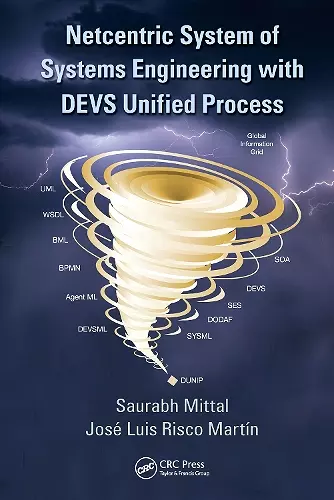Netcentric System of Systems Engineering with DEVS Unified Process
Saurabh Mittal author José L Risco Martín author
Format:Hardback
Publisher:Taylor & Francis Inc
Published:22nd Feb '13
Currently unavailable, and unfortunately no date known when it will be back
This hardback is available in another edition too:
- Paperback£100.00(9781138076594)

In areas such as military, security, aerospace, and disaster management, the need for performance optimization and interoperability among heterogeneous systems is increasingly important. Model-driven engineering, a paradigm in which the model becomes the actual software, offers a promising approach toward systems of systems (SoS) engineering. However, model-driven engineering has largely been unachieved in complex dynamical systems and netcentric SoS, partly because modeling and simulation (M&S) frameworks are stove-piped and not designed for SoS composability. Addressing this gap, Netcentric System of Systems Engineering with DEVS Unified Process presents a methodology for realizing the model-driven engineering vision and netcentric SoS using DEVS Unified Process (DUNIP).
The authors draw on their experience with Discrete Event Systems Specification (DEVS) formalism, System Entity Structure (SES) theory, and applying model-driven engineering in the context of a netcentric SoS. They describe formal model-driven engineering methods for netcentric M&S using standards-based approaches to develop and test complex dynamic models with DUNIP. The book is organized into five sections:
- Section I introduces undergraduate students and novices to the world of DEVS. It covers systems and SoS M&S as well as DEVS formalism, software, modeling language, and DUNIP. It also assesses DUNIP with the requirements of the Department of Defense’s (DoD) Open Unified Technical Framework (OpenUTF) for netcentric Test and Evaluation (T&E).
- Section II delves into M&S-based systems engineering for graduate students, advanced practitioners, and industry professionals. It provides methodologies to apply M&S principles to SoS design and reviews the development of executable architectures based on a framework such as the Department of Defense Architecture Framework (DoDAF). It also describes an approach for building netcentric knowledge-based contingency-driven systems.
- Section III guides graduate students, advanced DEVS users, and industry professionals who are interested in building DEVS virtual machines and netcentric SoS. It discusses modeling standardization, the deployment of models and simulators in a netcentric environment, event-driven architectures, and more.
- Section IV explores real-world case studies that realize many of the concepts defined in the previous chapters.
- Section V outlines the next steps and looks at how the modeling of netcentric complex adaptive systems can be attempted using DEVS concepts. It touches on the boundaries of DEVS formalism and the future work needed to utilize advanced concepts like weak and strong emergence, self-organization, scale-free systems, run-time modularity,...
"The book is the first to expose the DEVS Unified Process (DUNIP), a methodology that employs the DEVS formalism to provide a sound modeling and simulation framework for model-driven systems engineering. Software and systems engineers at the cutting edge of intelligent system technologies will be particularly interested in the fact that the book extends DUNIP to apply to systems capable of complex adaptive and emergent behaviors."
—Bernard P. Zeigler, the father of DEVS formalism, University of Arizona, USA
"This book is among the first to coherently and concisely address the challenge to integrate modeling and simulation (M&S) as one of the emerging decision support tools of the 21st century into this netcentric environment. ... The task for integrating solutions that are implemented on heterogeneous IT systems and that were developed independently from each other, but that nonetheless shall support homogeneous presentation of required functionality to the user, is supported by netcentric system of systems. The book brings both aspects together successfully and proposes a general solution that merges successful formal approaches with state-of-the-art engineering solutions. Although the case studies are taken from the defense domain, the applicability of the recommended approach to all domains of M&S—such as business, transportation, and medical—is given implicitly, as formalism as well as engineering solutions are accepted in these domains."
—Andreas Tolk, Ph.D., Old Dominion University, USA
"… there is interesting content in this book for systems engineers who are interested in model-based systems engineering and in different kinds of simulation, as well as those interested in how the software for distributed systems of computer systems can be modeled.
—INCOSE INSIGHT, December 2013
"The book is the first to expose the DEVS Unified Process (DUNIP), a methodology that employs the DEVS formalism to provide a sound modeling and simulation framework for model-driven systems engineering. Software and systems engineers at the cutting edge of intelligent system technologies will be particularly interested in the fact that the book extends DUNIP to apply to systems capable of complex adaptive and emergent behaviors."—Bernard P. Zeigler, the father of DEVS formalism, University of Arizona, USA
"This book is among the first to coherently and concisely address the challenge to integrate modeling and simulation (M&S) as one of the emerging decision support tools of the 21st century into this netcentric environment. ... The task for integrating solutions that are implemented on heterogeneous IT systems and that were developed independently from each other, but that nonetheless shall support homogeneous presentation of required functionality to the user, is supported by netcentric system of systems. The book brings both aspects together successfully and proposes a general solution that merges successful formal approaches with state-of-the-art engineering solutions. Although the case studies are taken from the defense domain, the applicability of the recommended approach to all domains of M&S—such as business, transportation, and medical—is given implicitly, as formalism as well as engineering solutions are accepted in these domains."—Andreas Tolk, Ph.D., Old Dominion University, USA
"… there is interesting content in this book for systems engineers who are interested in model-based systems engineering and in different kinds of simulation, as well as those interested in how the software for distributed systems of computer systems can be modeled."—INCOSE INSIGHT, December 2013
ISBN: 9781439827062
Dimensions: unknown
Weight: 1133g
712 pages